Michael Faraday
Michael Faraday FRS (/ˈfærədeɪ, -di/; 22 September 1791 – 25 August 1867) was an English scientist who contributed to the study of electromagnetism and electrochemistry. His main discoveries include the principles underlying electromagnetic induction, diamagnetism and electrolysis.
Michael Faraday | |
|---|---|
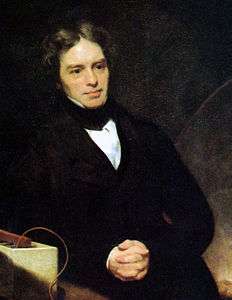 Painting of Faraday (1842) by Thomas Phillips | |
| Born | 22 September 1791 Newington Butts, England |
| Died | 25 August 1867 (aged 75) Hampton Court, Middlesex, England |
| Nationality | British |
| Known for | Faraday's law of induction Electrochemistry Faraday effect Faraday cage Faraday constant Faraday cup Faraday's laws of electrolysis Faraday paradox Faraday rotator Faraday-efficiency effect Faraday wave Faraday wheel Lines of force Rubber Balloon |
| Spouse(s) | Sarah Barnard ( m. 1821) |
| Awards | Royal Medal (1835 and 1846) Copley Medal (1832 and 1838) Rumford Medal (1846) Albert Medal (1866) |
| Scientific career | |
| Fields | Physics Chemistry |
| Institutions | Royal Institution |
| Influences | Humphry Davy William Thomas Brande |
| Signature | |
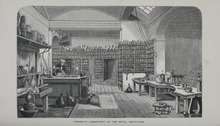
Although Faraday received little formal education, he was one of the most influential scientists in history. It was by his research on the magnetic field around a conductor carrying a direct current that Faraday established the basis for the concept of the electromagnetic field in physics. Faraday also established that magnetism could affect rays of light and that there was an underlying relationship between the two phenomena.[1][2] He similarly discovered the principles of electromagnetic induction and diamagnetism, and the laws of electrolysis. His inventions of electromagnetic rotary devices formed the foundation of electric motor technology, and it was largely due to his efforts that electricity became practical for use in technology.
As a chemist, Faraday discovered benzene, investigated the clathrate hydrate of chlorine, invented an early form of the Bunsen burner and the system of oxidation numbers, and popularised terminology such as "anode", "cathode", "electrode" and "ion". Faraday ultimately became the first and foremost Fullerian Professor of Chemistry at the Royal Institution, a lifetime position.
Faraday was an excellent experimentalist who conveyed his ideas in clear and simple language; his mathematical abilities, however, did not extend as far as trigonometry and were limited to the simplest algebra. James Clerk Maxwell took the work of Faraday and others and summarized it in a set of equations which is accepted as the basis of all modern theories of electromagnetic phenomena. On Faraday's uses of lines of force, Maxwell wrote that they show Faraday "to have been in reality a mathematician of a very high order – one from whom the mathematicians of the future may derive valuable and fertile methods."[3] The SI unit of capacitance is named in his honour: the farad.
Albert Einstein kept a picture of Faraday on his study wall, alongside pictures of Isaac Newton and James Clerk Maxwell.[4] Physicist Ernest Rutherford stated, "When we consider the magnitude and extent of his discoveries and their influence on the progress of science and of industry, there is no honour too great to pay to the memory of Faraday, one of the greatest scientific discoverers of all time."[5]
Personal life
Early life
—Joel H. Hildebrand's Education for Creativity in the Sciences speech at New York University, 1963.[6]
Michael Faraday was born on 22 September 1791 in Newington Butts,[7] which is now part of the London Borough of Southwark but was then a suburban part of Surrey.[8] His family was not well off. His father, James, was a member of the Glassite sect of Christianity. James Faraday moved his wife and two children to London during the winter of 1790 from Outhgill in Westmorland, where he had been an apprentice to the village blacksmith.[9] Michael was born in the autumn of that year. The young Michael Faraday, who was the third of four children, having only the most basic school education, had to educate himself.[10]
At the age of 14 he became an apprentice to George Riebau, a local bookbinder and bookseller in Blandford Street.[11] During his seven-year apprenticeship Faraday read many books, including Isaac Watts's The Improvement of the Mind, and he enthusiastically implemented the principles and suggestions contained therein.[12] He also developed an interest in science, especially in electricity. Faraday was particularly inspired by the book Conversations on Chemistry by Jane Marcet.[13][14]
Adult life

In 1812, at the age of 20 and at the end of his apprenticeship, Faraday attended lectures by the eminent English chemist Humphry Davy of the Royal Institution and the Royal Society, and John Tatum, founder of the City Philosophical Society. Many of the tickets for these lectures were given to Faraday by William Dance, who was one of the founders of the Royal Philharmonic Society. Faraday subsequently sent Davy a 300-page book based on notes that he had taken during these lectures. Davy's reply was immediate, kind, and favourable. In 1813, when Davy damaged his eyesight in an accident with nitrogen trichloride, he decided to employ Faraday as an assistant. Coincidentally one of the Royal Institution's assistants, John Payne, was sacked and Sir Humphry Davy had been asked to find a replacement; thus he appointed Faraday as Chemical Assistant at the Royal Institution on 1 March 1813.[1] Very soon Davy entrusted Faraday with the preparation of nitrogen trichloride samples, and they both were injured in an explosion of this very sensitive substance.[15]
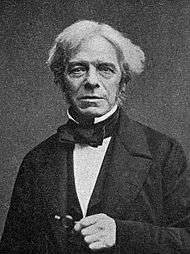
Faraday married Sarah Barnard (1800–1879) on 12 June 1821.[16] They met through their families at the Sandemanian church, and he confessed his faith to the Sandemanian congregation the month after they were married. They had no children.[7]
Faraday was a devout Christian; his Sandemanian denomination was an offshoot of the Church of Scotland. Well after his marriage, he served as deacon and for two terms as an elder in the meeting house of his youth. His church was located at Paul's Alley in the Barbican. This meeting house relocated in 1862 to Barnsbury Grove, Islington; this North London location was where Faraday served the final two years of his second term as elder prior to his resignation from that post.[17][18] Biographers have noted that "a strong sense of the unity of God and nature pervaded Faraday's life and work."[19]
Later life
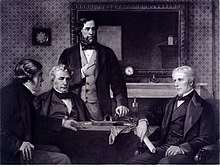
In June 1832, the University of Oxford granted Faraday an honorary Doctor of Civil Law degree. During his lifetime, he was offered a knighthood in recognition for his services to science, which he turned down on religious grounds, believing that it was against the word of the Bible to accumulate riches and pursue worldly reward, and stating that he preferred to remain "plain Mr Faraday to the end".[20] Elected a member of the Royal Society in 1824, he twice refused to become President.[21] He became the first Fullerian Professor of Chemistry at the Royal Institution in 1833.[22]
In 1832, Faraday was elected a Foreign Honorary Member of the American Academy of Arts and Sciences.[23] He was elected a foreign member of the Royal Swedish Academy of Sciences in 1838, and was one of eight foreign members elected to the French Academy of Sciences in 1844.[24] In 1849 he was elected as associated member to the Royal Institute of the Netherlands, which two years later became the Royal Netherlands Academy of Arts and Sciences and he was subsequently made foreign member.[25]
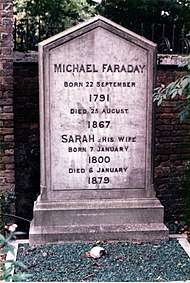
Faraday suffered a nervous breakdown in 1839 but eventually returned to his investigations into electromagnetism.[26] In 1848, as a result of representations by the Prince Consort, Faraday was awarded a grace and favour house in Hampton Court in Middlesex, free of all expenses and upkeep. This was the Master Mason's House, later called Faraday House, and now No. 37 Hampton Court Road. In 1858 Faraday retired to live there.[27]
Having provided a number of various service projects for the British government, when asked by the government to advise on the production of chemical weapons for use in the Crimean War (1853–1856), Faraday refused to participate citing ethical reasons.[28]
Faraday died at his house at Hampton Court on 25 August 1867, aged 75.[29] He had some years before turned down an offer of burial in Westminster Abbey upon his death, but he has a memorial plaque there, near Isaac Newton's tomb. Faraday was interred in the dissenters' (non-Anglican) section of Highgate Cemetery.
Scientific achievements
Chemistry
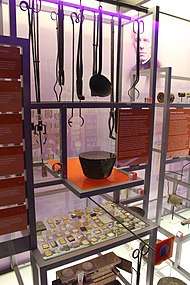
Faraday's earliest chemical work was as an assistant to Humphry Davy. Faraday was specifically involved in the study of chlorine; he discovered two new compounds of chlorine and carbon. He also conducted the first rough experiments on the diffusion of gases, a phenomenon that was first pointed out by John Dalton. The physical importance of this phenomenon was more fully revealed by Thomas Graham and Joseph Loschmidt. Faraday succeeded in liquefying several gases, investigated the alloys of steel, and produced several new kinds of glass intended for optical purposes. A specimen of one of these heavy glasses subsequently became historically important; when the glass was placed in a magnetic field Faraday determined the rotation of the plane of polarisation of light. This specimen was also the first substance found to be repelled by the poles of a magnet.
Faraday invented an early form of what was to become the Bunsen burner, which is in practical use in science laboratories around the world as a convenient source of heat.[30][31] Faraday worked extensively in the field of chemistry, discovering chemical substances such as benzene (which he called bicarburet of hydrogen) and liquefying gases such as chlorine. The liquefying of gases helped to establish that gases are the vapours of liquids possessing a very low boiling point and gave a more solid basis to the concept of molecular aggregation. In 1820 Faraday reported the first synthesis of compounds made from carbon and chlorine, C2Cl6 and C2Cl4, and published his results the following year.[32][33][34] Faraday also determined the composition of the chlorine clathrate hydrate, which had been discovered by Humphry Davy in 1810.[35][36] Faraday is also responsible for discovering the laws of electrolysis, and for popularizing terminology such as anode, cathode, electrode, and ion, terms proposed in large part by William Whewell.[37]
Faraday was the first to report what later came to be called metallic nanoparticles. In 1847 he discovered that the optical properties of gold colloids differed from those of the corresponding bulk metal. This was probably the first reported observation of the effects of quantum size, and might be considered to be the birth of nanoscience.[38]
Electricity and magnetism
Faraday is best known for his work regarding electricity and magnetism. His first recorded experiment was the construction of a voltaic pile with seven ha'penny coins, stacked together with seven disks of sheet zinc, and six pieces of paper moistened with salt water. With this pile he decomposed sulfate of magnesia (first letter to Abbott, 12 July 1812).
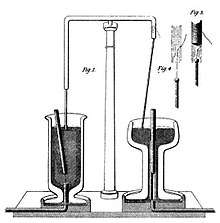
In 1821, soon after the Danish physicist and chemist Hans Christian Ørsted discovered the phenomenon of electromagnetism, Davy and British scientist William Hyde Wollaston tried, but failed, to design an electric motor.[2] Faraday, having discussed the problem with the two men, went on to build two devices to produce what he called "electromagnetic rotation". One of these, now known as the homopolar motor, caused a continuous circular motion that was engendered by the circular magnetic force around a wire that extended into a pool of mercury wherein was placed a magnet; the wire would then rotate around the magnet if supplied with current from a chemical battery. These experiments and inventions formed the foundation of modern electromagnetic technology. In his excitement, Faraday published results without acknowledging his work with either Wollaston or Davy. The resulting controversy within the Royal Society strained his mentor relationship with Davy and may well have contributed to Faraday's assignment to other activities, which consequently prevented his involvement in electromagnetic research for several years.[40][41]
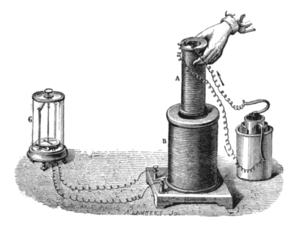
From his initial discovery in 1821, Faraday continued his laboratory work, exploring electromagnetic properties of materials and developing requisite experience. In 1824, Faraday briefly set up a circuit to study whether a magnetic field could regulate the flow of a current in an adjacent wire, but he found no such relationship.[42] This experiment followed similar work conducted with light and magnets three years earlier that yielded identical results.[43][44] During the next seven years, Faraday spent much of his time perfecting his recipe for optical quality (heavy) glass, borosilicate of lead,[45] which he used in his future studies connecting light with magnetism.[46] In his spare time, Faraday continued publishing his experimental work on optics and electromagnetism; he conducted correspondence with scientists whom he had met on his journeys across Europe with Davy, and who were also working on electromagnetism.[47] Two years after the death of Davy, in 1831, he began his great series of experiments in which he discovered electromagnetic induction, recording in his laboratory diary on 28 October 1831 he was; "making many experiments with the great magnet of the Royal Society".[48]

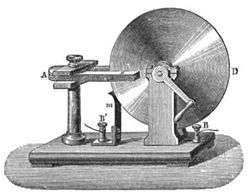
Faraday's breakthrough came when he wrapped two insulated coils of wire around an iron ring, and found that upon passing a current through one coil, a momentary current was induced in the other coil.[2] This phenomenon is now known as mutual induction.[49] The iron ring-coil apparatus is still on display at the Royal Institution. In subsequent experiments, he found that if he moved a magnet through a loop of wire an electric current flowed in that wire. The current also flowed if the loop was moved over a stationary magnet. His demonstrations established that a changing magnetic field produces an electric field; this relation was modelled mathematically by James Clerk Maxwell as Faraday's law, which subsequently became one of the four Maxwell equations, and which have in turn evolved into the generalization known today as field theory.[50] Faraday would later use the principles he had discovered to construct the electric dynamo, the ancestor of modern power generators and the electric motor.[51]
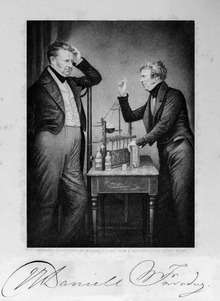
In 1832, he completed a series of experiments aimed at investigating the fundamental nature of electricity; Faraday used "static", batteries, and "animal electricity" to produce the phenomena of electrostatic attraction, electrolysis, magnetism, etc. He concluded that, contrary to the scientific opinion of the time, the divisions between the various "kinds" of electricity were illusory. Faraday instead proposed that only a single "electricity" exists, and the changing values of quantity and intensity (current and voltage) would produce different groups of phenomena.[2]
Near the end of his career, Faraday proposed that electromagnetic forces extended into the empty space around the conductor.[50] This idea was rejected by his fellow scientists, and Faraday did not live to see the eventual acceptance of his proposition by the scientific community. Faraday's concept of lines of flux emanating from charged bodies and magnets provided a way to visualize electric and magnetic fields; that conceptual model was crucial for the successful development of the electromechanical devices that dominated engineering and industry for the remainder of the 19th century.
Diamagnetism
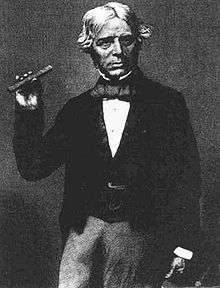
In 1845, Faraday discovered that many materials exhibit a weak repulsion from a magnetic field: a phenomenon he termed diamagnetism.[53]
Faraday also discovered that the plane of polarization of linearly polarized light can be rotated by the application of an external magnetic field aligned with the direction in which the light is moving. This is now termed the Faraday effect.[50] In Sept 1845 he wrote in his notebook, "I have at last succeeded in illuminating a magnetic curve or line of force and in magnetising a ray of light".[54]
Later on in his life, in 1862, Faraday used a spectroscope to search for a different alteration of light, the change of spectral lines by an applied magnetic field. The equipment available to him was, however, insufficient for a definite determination of spectral change. Pieter Zeeman later used an improved apparatus to study the same phenomenon, publishing his results in 1897 and receiving the 1902 Nobel Prize in Physics for his success. In both his 1897 paper[55] and his Nobel acceptance speech,[56] Zeeman made reference to Faraday's work.
Faraday cage
In his work on static electricity, Faraday's ice pail experiment demonstrated that the charge resided only on the exterior of a charged conductor, and exterior charge had no influence on anything enclosed within a conductor. This is because the exterior charges redistribute such that the interior fields emanating from them cancel one another. This shielding effect is used in what is now known as a Faraday cage.[50]
Royal Institution and public service
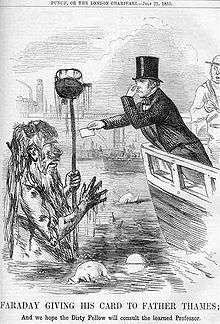
Faraday had a long association with the Royal Institution of Great Britain. He was appointed Assistant Superintendent of the House of the Royal Institution in 1821.[57] He was elected a member of the Royal Society in 1824.[7] In 1825, he became Director of the Laboratory of the Royal Institution.[57] Six years later, in 1833, Faraday became the first Fullerian Professor of Chemistry at the Royal Institution of Great Britain, a position to which he was appointed for life without the obligation to deliver lectures. His sponsor and mentor was John 'Mad Jack' Fuller, who created the position at the Royal Institution for Faraday.[58]
Beyond his scientific research into areas such as chemistry, electricity, and magnetism at the Royal Institution, Faraday undertook numerous, and often time-consuming, service projects for private enterprise and the British government. This work included investigations of explosions in coal mines, being an expert witness in court, and along with two engineers from Chance Brothers c.1853, the preparation of high-quality optical glass, which was required by Chance for its lighthouses. In 1846, together with Charles Lyell, he produced a lengthy and detailed report on a serious explosion in the colliery at Haswell, County Durham, which killed 95 miners. Their report was a meticulous forensic investigation and indicated that coal dust contributed to the severity of the explosion. The report should have warned coal owners of the hazard of coal dust explosions, but the risk was ignored for over 60 years until the Senghenydd Colliery Disaster of 1913.
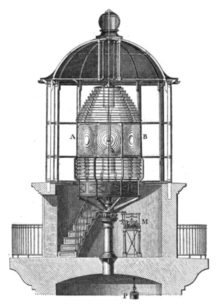
As a respected scientist in a nation with strong maritime interests, Faraday spent extensive amounts of time on projects such as the construction and operation of lighthouses and protecting the bottoms of ships from corrosion. His workshop still stands at Trinity Buoy Wharf above the Chain and Buoy Store, next to London's only lighthouse where he carried out the first experiments in electric lighting for lighthouses.[59]
Faraday was also active in what would now be called environmental science, or engineering. He investigated industrial pollution at Swansea and was consulted on air pollution at the Royal Mint. In July 1855, Faraday wrote a letter to The Times on the subject of the foul condition of the River Thames, which resulted in an often-reprinted cartoon in Punch. (See also The Great Stink).[60]

Faraday assisted with the planning and judging of exhibits for the Great Exhibition of 1851 in London. He also advised the National Gallery on the cleaning and protection of its art collection, and served on the National Gallery Site Commission in 1857.[61][62] Education was another of Faraday's areas of service; he lectured on the topic in 1854 at the Royal Institution,[63] and in 1862 he appeared before a Public Schools Commission to give his views on education in Great Britain. Faraday also weighed in negatively on the public's fascination with table-turning,[64][65] mesmerism, and seances, and in so doing chastised both the public and the nation's educational system.[66]

Before his famous Christmas lectures, Faraday delivered chemistry lectures for the City Philosophical Society from 1816 to 1818 in order to refine the quality of his lectures.[67] Between 1827 and 1860 at the Royal Institution in London, Faraday gave a series of nineteen Christmas lectures for young people, a series which continues today. The objective of Faraday's Christmas lectures was to present science to the general public in the hopes of inspiring them and generating revenue for the Royal Institution. They were notable events on the social calendar among London's gentry. Over the course of several letters to his close friend Benjamin Abbott, Faraday outlined his recommendations on the art of lecturing: Faraday wrote "a flame should be lighted at the commencement and kept alive with unremitting splendour to the end".[68] His lectures were joyful and juvenile, he delighted in filling soap bubbles with various gasses (in order to determine whether or not they are magnetic) in front of his audiences and marveled at the rich colors of polarized lights, but the lectures were also deeply philosophical. In his lectures he urged his audiences to consider the mechanics of his experiments: "you know very well that ice floats upon water ... Why does the ice float? Think of that, and philosophise".[69] His subjects consisted of Chemistry and Electricity, and included: 1841 The Rudiments of Chemistry, 1843 First Principles of Electricity, 1848 The Chemical History of a Candle, 1851 Attractive Forces, 1853 Voltaic Electricity, 1854 The Chemistry of Combustion, 1855 The Distinctive Properties of the Common Metals, 1857 Static Electricity, 1858 The Metallic Properties, 1859 The Various Forces of Matter and their Relations to Each Other.[70]
Commemorations

A statue of Faraday stands in Savoy Place, London, outside the Institution of Engineering and Technology. The Michael Faraday Memorial, designed by brutalist architect Rodney Gordon and completed in 1961, is at the Elephant & Castle gyratory system, near Faraday's birthplace at Newington Butts, London. Faraday School is located on Trinity Buoy Wharf where his workshop still stands above the Chain and Buoy Store, next to London's only lighthouse.[71] Faraday Gardens is a small park in Walworth, London, not far from his birthplace at Newington Butts. It lies within the local council ward of Faraday in the London Borough of Southwark. Michael Faraday Primary school is situated on the Aylesbury Estate in Walworth.[72]
A building at London South Bank University, which houses the institute's electrical engineering departments is named the Faraday Wing, due to its proximity to Faraday's birthplace in Newington Butts. A hall at Loughborough University was named after Faraday in 1960. Near the entrance to its dining hall is a bronze casting, which depicts the symbol of an electrical transformer, and inside there hangs a portrait, both in Faraday's honour. An eight-story building at the University of Edinburgh's science & engineering campus is named for Faraday, as is a recently built hall of accommodation at Brunel University, the main engineering building at Swansea University, and the instructional and experimental physics building at Northern Illinois University. The former UK Faraday Station in Antarctica was named after him.[73]
—Albert Einstein's speech on intellectual freedom at the Royal Albert Hall, London having fled Nazi Germany, 3 October 1933.[74]
Streets named for Faraday can be found in many British cities (e.g., London, Fife, Swindon, Basingstoke, Nottingham, Whitby, Kirkby, Crawley, Newbury, Swansea, Aylesbury and Stevenage) as well as in France (Paris), Germany (Berlin-Dahlem, Hermsdorf), Canada (Quebec City, Quebec; Deep River, Ontario; Ottawa, Ontario), and the United States (Reston, Virginia).

A Royal Society of Arts blue plaque, unveiled in 1876, commemorates Faraday at 48 Blandford Street in London's Marylebone district.[75] From 1991 until 2001, Faraday's picture featured on the reverse of Series E £20 banknotes issued by the Bank of England. He was portrayed conducting a lecture at the Royal Institution with the magneto-electric spark apparatus.[76] In 2002, Faraday was ranked number 22 in the BBC's list of the 100 Greatest Britons following a UK-wide vote.[77]
The Faraday Institute for Science and Religion derives its name from the scientist, who saw his faith as integral to his scientific research. The logo of the Institute is also based on Faraday's discoveries. It was created in 2006 by a $2,000,000 grant from the John Templeton Foundation to carry out academic research, to foster understanding of the interaction between science and religion, and to engage public understanding in both these subject areas.[78][79]
Faraday's life and contributions to electromagnetics was the principal topic of the tenth episode, titled "The Electric Boy", of the 2014 American science documentary series, Cosmos: A Spacetime Odyssey, which was broadcast on Fox and the National Geographic Channel.[80]
Aldous Huxley, the literary giant who was also the grandson of T. H. Huxley, the grandnephew of Matthew Arnold, the brother of Julian Huxley, and the half-brother of Andrew Huxley, was well-versed in science. He wrote about Faraday in an essay entitled, A Night in Pietramala: “He is always the natural philosopher. To discover truth is his sole aim and interest…even if I could be Shakespeare, I think I should still choose to be Faraday.”[81]
Awards named in Faraday's honor
In honor and remembrance of his great scientific contributions, several institutions have created prizes and awards in his name. This include:
- The IET Faraday Medal
- The Royal Society of London Michael Faraday Prize[82]
- The Institute of Physics Michael Faraday Medal and Prize[83]
- The Royal Society of Chemistry Faraday Lectureship Prize[84]
Gallery
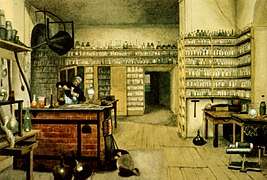 Michael Faraday in his laboratory, c. 1850s.
Michael Faraday in his laboratory, c. 1850s. Michael Faraday's study at the Royal Institution.
Michael Faraday's study at the Royal Institution. Michael Faraday's flat at the Royal Institution.
Michael Faraday's flat at the Royal Institution. Artist Harriet Jane Moore who documented Faraday's life in watercolours.
Artist Harriet Jane Moore who documented Faraday's life in watercolours.
Bibliography

| Library resources about Michael Faraday |
| By Michael Faraday |
|---|
Faraday's books, with the exception of Chemical Manipulation, were collections of scientific papers or transcriptions of lectures.[85] Since his death, Faraday's diary has been published, as have several large volumes of his letters and Faraday's journal from his travels with Davy in 1813–1815.
- Faraday, Michael (1827). Chemical Manipulation, Being Instructions to Students in Chemistry. John Murray. 2nd ed. 1830, 3rd ed. 1842
- Faraday, Michael (1839). Experimental Researches in Electricity, vols. i. and ii. Richard and John Edward Taylor.; vol. iii. Richard Taylor and William Francis, 1855
- Faraday, Michael (1859). Experimental Researches in Chemistry and Physics. Taylor and Francis. ISBN 978-0-85066-841-4.
- Faraday, Michael (1861). W. Crookes (ed.). A Course of Six Lectures on the Chemical History of a Candle. Griffin, Bohn & Co. ISBN 978-1-4255-1974-2.
- Faraday, Michael (1873). W. Crookes (ed.). On the Various Forces in Nature. Chatto and Windus.
- Faraday, Michael (1932–1936). T. Martin (ed.). Diary. ISBN 978-0-7135-0439-2. – published in eight volumes; see also the 2009 publication of Faraday's diary
- Faraday, Michael (1991). B. Bowers and L. Symons (ed.). Curiosity Perfectly Satisfyed: Faraday's Travels in Europe 1813–1815. Institution of Electrical Engineers.
- Faraday, Michael (1991). F.A.J.L. James (ed.). The Correspondence of Michael Faraday. 1. INSPEC, Inc. ISBN 978-0-86341-248-6. – volume 2, 1993; volume 3, 1996; volume 4, 1999
- Faraday, Michael (2008). Alice Jenkins (ed.). Michael Faraday's Mental Exercises: An Artisan Essay Circle in Regency London. Liverpool: Liverpool University Press.
- Course of six lectures on the various forces of matter, and their relations to each other London; Glasgow: R. Griffin, 1860.
- The Liquefaction of Gases, Edinburgh: W.F. Clay, 1896.
- The letters of Faraday and Schoenbein 1836–1862. With notes, comments and references to contemporary letters London: Williams & Norgate 1899. (Digital edition by the University and State Library Düsseldorf)
See also
- Faraday (Unit of electrical charge)
- Forensic engineering
- Homopolar generator
- Timeline of hydrogen technologies
- Timeline of low-temperature technology
- Zeeman effect
References
- Chisholm, Hugh, ed. (1911). . Encyclopædia Britannica. 10 (11th ed.). Cambridge University Press. pp. 173–175.. the 1911 Encyclopædia Britannica.
- "Archives Michael Faraday biography – The IET". theiet.org.
- The Scientific Papers of James Clerk Maxwell Volume 1 p. 360; Courier Dover 2003, ISBN 0-486-49560-4
- Gleeson-White, Jane (10 November 2003). "Einstein's Heroes (book review)". The Sydney Morning Herald. Retrieved 24 October 2017.
- Rao, C.N.R. (2000). Understanding Chemistry. Universities Press. ISBN 81-7371-250-6. p. 281.
- Gene Currivan (16 Jun 1963). "I.Q. Tests Called Harmful to Pupil", New York Times
- James, Frank A. J. L. (2011) [2004]. "Faraday, Michael (1791–1867)". Oxford Dictionary of National Biography (online ed.). Oxford University Press. doi:10.1093/ref:odnb/9153. (Subscription or UK public library membership required.)
- For a concise account of Faraday's life including his childhood, see pp. 175–183 of Every Saturday: A Journal of Choice Reading, Vol III published at Cambridge in 1873 by Osgood & Co.
- The implication is that James discovered job opportunities elsewhere through membership of this sect. James joined the London meeting house on 20 February 1791, and moved his family shortly thereafter. See Cantor, pp. 57–58.
- "Michael Faraday." History of Science and Technology. Houghton Mifflin Company, 2004. Answers.com 4 June 2007
- Plaque #19 on Open Plaques.
- Jenkins, Alice (2008). Michael Faraday's Mental Exercises: An Artisan Essay-Circle in Regency London. Oxford University Press. p. 213.
- Lienhard, John H. (1992). "Michael Faraday". The Engines of Our Ingenuity. Episode 741. NPR. KUHF-FM Houston. No 741: Michael Faraday (transcript).
|access-date=requires|url=(help) - Lienhard, John H. (1992). "Jane Marcet's Books". The Engines of Our Ingenuity. Episode 744. NPR. KUHF-FM Houston. No 744: Jane Marcet's Books (transcript).
|access-date=requires|url=(help) - Thomas, p. 17
- The register at St. Faith-in-the-Virgin near St. Paul's Cathedral, records 12 June as the date their licence was issued. The witness was Sarah's father, Edward. Their marriage was 16 years prior to the Marriage and Registration Act of 1837. See Cantor, p. 59.
- Cantor, pp. 41–43, 60–64, and 277–280.
- Paul's Alley was located 10 houses south of the Barbican. See p. 330 Elmes's (1831) Topographical Dictionary of the British Metropolis.
- Baggott, Jim (2 September 1991). "The myth of Michael Faraday: Michael Faraday was not just one of Britain's greatest experimenters. A closer look at the man and his work reveals that he was also a clever theoretician". New Scientist. Retrieved 6 September 2008.
- West, Krista (2013). The Basics of Metals and Metalloids. Rosen Publishing Group. ISBN 1-4777-2722-1. p. 81.
- Todd Timmons (2012). "Makers of Western Science: The Works and Words of 24 Visionaries from Copernicus to Watson and Crick". p. 127.
- "Faraday appointed first Fullerian Professor of Chemistry". The Royal Institution. 16 October 2017.
- "Book of Members, 1780–2010: Chapter F" (PDF). American Academy of Arts and Sciences. Retrieved 15 September 2016.
- Gladstone, John Hall (1872). Michael Faraday. London: Macmillan and Company. p. 53.
Faraday French Academy.
- "M. Faraday (1791–1867)". Royal Netherlands Academy of Arts and Sciences. Retrieved 17 July 2015.
- Bowden, Mary Ellen (1997). Chemical Achievers: The Human Face of the Chemical Sciences. Chemical Heritage Foundation. ISBN 0-941901-12-2. p. 30.
- Twickenham Museum on Faraday and Faraday House; accessed 14 August 2014.
- Croddy, Eric; Wirtz, James J. (2005). Weapons of Mass Destruction: An Encyclopedia of Worldwide Policy, Technology, and History. ABC-CLIO. p. 86. ISBN 978-1-85109-490-5.
- Plaque #2429 on Open Plaques.
- Jensen, William B. (2005). "The Origin of the Bunsen Burner" (PDF). Journal of Chemical Education. 82 (4): 518. Bibcode:2005JChEd..82..518J. doi:10.1021/ed082p518.
- Faraday (1827), p. 127.
- Faraday, Michael (1821). "On two new Compounds of Chlorine and Carbon, and on a new Compound of Iodine, Carbon, and Hydrogen". Philosophical Transactions. 111: 47–74. doi:10.1098/rstl.1821.0007.
- Faraday, Michael (1859). Experimental Researches in Chemistry and Physics. London: Richard Taylor and William Francis. pp. 33–53. ISBN 978-0-85066-841-4.
- Williams, L. Pearce (1965). Michael Faraday: A Biography. New York: Basic Books. pp. 122–123. ISBN 978-0-306-80299-7.
- Faraday, Michael (1823). "On Hydrate of Chlorine". Quarterly Journal of Science. 15: 71.
- Faraday, Michael (1859). Experimental Researches in Chemistry and Physics. London: Richard Taylor and William Francis. pp. 81–84. ISBN 978-0-85066-841-4.
- Ehl, Rosemary Gene; Ihde, Aaron (1954). "Faraday's Electrochemical Laws and the Determination of Equivalent Weights". Journal of Chemical Education. 31 (May): 226–232. Bibcode:1954JChEd..31..226E. doi:10.1021/ed031p226.
- "The Birth of Nanotechnology". Nanogallery.info. 2006. Retrieved 25 July 2007.
Faraday made some attempt to explain what was causing the vivid coloration in his gold mixtures, saying that known phenomena seemed to indicate that a mere variation in the size of gold particles gave rise to a variety of resultant colors.
- Faraday, Michael (1844). Experimental Researches in Electricity. 2. ISBN 978-0-486-43505-3. See plate 4.
- Hamilton, pp. 165–171, 183, 187–190.
- Cantor, pp. 231–233.
- Thompson, p. 95.
- Thompson, p. 91. This lab entry illustrates Faraday's quest for the connection between light and electromagnetic phenomenon 10 September 1821.
- Cantor, p. 233.
- Thompson, pp. 95–98.
- Thompson, p. 100.
- Faraday's initial induction lab work occurred in late November 1825. His work was heavily influenced by the ongoing research of fellow European scientists Ampere, Arago, and Oersted as indicated by his diary entries. Cantor, pp. 235–244.
- Gooding, David; Pinch, Trevor; Schaffer, Simon (1989). The Uses of Experiment: Studies in the Natural Sciences. Cambridge University Press. ISBN 0-521-33768-2. p. 212.
- Van Valkenburgh (1995). Basic Electricity. Cengage Learning. ISBN 0-7906-1041-8. pp. 4–91.
- Lives and Times of Great Pioneers in Chemistry (lavoisier to Sanger). World Scientific. 2015. pp. 85, 86.
- "Michael Faraday's generator". The Royal Institution. 15 October 2017.
- "Detail of an engraving by Henry Adlard, based on earlier photograph by Maull & Polyblank ca. 1857". National Portrait Gallery, UK: NPR.
- James, Frank A.J.L (2010). Michael Faraday: A Very Short Introduction. Oxford University Press. ISBN 0-19-161446-7. p. 81.
- Day, Peter (1999). The Philosopher's Tree: A Selection of Michael Faraday's Writings. CRC Press. ISBN 0-7503-0570-3. p. 125.
- Zeeman, Pieter (1897). "The Effect of Magnetisation on the Nature of Light Emitted by a Substance". Nature. 55 (1424): 347. Bibcode:1897Natur..55..347Z. doi:10.1038/055347a0.
- "Pieter Zeeman, Nobel Lecture". Retrieved 29 May 2008.
- "Michael Faraday (1791–1867)". The Royal Institution. Retrieved 20 February 2014.
- Jones, Roger (2009). What's Who?: A Dictionary of Things Named After People and the People They are Named After. Troubador Publishing Ltd. p. 74.
- Smith, Denis (2001). London and the Thames Valley. Thomas Telford. ISBN 0-7277-2876-8. p. 236.
- Faraday, Michael (9 July 1855). "The State of the Thames". The Times. p. 8.
- "No. 21950". The London Gazette. 16 December 1856. p. 4219.
- Thomas, p. 83
- Royal Institution of Great Britain; Whewell, William; Faraday, Michael; Latham, Robert Gordon; Daubeny, Charles; Tyndall, John; Paget, James; Hodgson, William Ballantyne; Lankester, E. Ray (Edwin Ray) (1917). Science and education; lectures delivered at the Royal institution of Great Britain. The Library of Congress. London, W. Heinemann. pp. 39–74 [51].
- See The Illustrated London News, 2 July 1853, p.530 for Faraday's comments.
- Thompson, Silvanus Phillips (1898). Michael Faraday; his life and work. Cornell University Library. London, Cassell. pp. 250–252.
- James, Frank A.J.L; Faraday, Michael (1991). The correspondence of Michael Faraday. Vol. 4. London: The Institution of Electrical Engineers. pp. xxx–xxii. ISBN 978-0-86341-251-6.
- Lan, B.L. (2001). "Michael Faraday: Prince of lecturers in Victorian England". The Physics Teacher. 39 (1): 32–36. Bibcode:2001PhTea..39...32L. doi:10.1119/1.1343427.
- Hirshfeld, Alan (2006). The Electric Life of Michael Faraday. New York: Walker & Company. ISBN 0-8027-1470-6
- Seeger, R.J. (1968). "Michael Faraday and the Art of Lecturing". Physics Today. 21 (8): 30–38. Bibcode:1968PhT....21h..30S. doi:10.1063/1.3035100.
- "History of the Christmas Lectures". The Royal Institution. Archived from the original on 9 June 2017. Retrieved 16 October 2017.
- Fisher, Stuart (2012). Rivers of Britain: Estuaries, tideways, havens, lochs, firths and kyles. A&C Black. ISBN 1-4081-5583-4. p. 231.
- Michael Faraday Primary School Archived 29 March 2012 at the Wayback Machine. michaelfaradayschool.co.uk
- Faraday Station F — History. antarctica.ac.uk
- "3 October 1933 – Albert Einstein presents his final speech given in Europe, at the Royal Albert Hall". Royal Albert Hall. 15 October 2017.
- "Faraday, Michael (1791–1867)". English Heritage. Retrieved 23 October 2012.
- "Withdrawn banknotes reference guide". Bank of England. Retrieved 17 October 2008.
- "BBC – Great Britons – Top 100". Internet Archive. Archived from the original on 4 December 2002. Retrieved 19 July 2017.
- "Faraday Institute for Science and Religion: Interdisciplinary Research and Projects". templeton.org. Archived from the original on 11 January 2012.
- About us Archived 13 December 2009 at the Wayback Machine, Faraday Institute
- Overbye, Dennis (4 March 2014). "A Successor to Sagan Reboots 'Cosmos'". The New York Times. Retrieved 17 June 2014.
- Huxley, Aldous (1925). A Night in Pietramala. In: Along the Road: Notes and Essays of a Tourist. New York: George H. Doran.
- "The Royal Society – Michael Faraday Prize".
- "Institute of Physics – Faraday Medal and Prize".
- "Royal Society of Chemistry – Faraday Lecture Prize".
- Hamilton, p. 220
Sources
- Cantor, Geoffrey (1991). Michael Faraday, Sandemanian and Scientist. Macmillan. ISBN 978-0-333-58802-4.
- Hamilton, James (2004). A Life of Discovery: Michael Faraday, Giant of the Scientific Revolution. New York: Random House. ISBN 978-1-4000-6016-0.
- Thomas, J.M. (1991). Michael Faraday and The Royal Institution: The Genius of Man and Place (PBK). CRC Press. ISBN 978-0-7503-0145-9.
- Thompson, Silvanus (1901). Michael Faraday, His Life and Work. London: Cassell and Company. ISBN 978-1-4179-7036-0.
Further reading
Biographies
- Agassi, Joseph (1971). Faraday as a Natural Philosopher. Chicago: University of Chicago Press.
- Ames, Joseph Sweetman (Ed.) (c. 1900). The Discovery of Induced Electric Currents. 2. New York: American Book Company (1890).CS1 maint: extra text: authors list (link)
- Bence Jones, Henry (1870). The Life and Letters of Faraday. Philadelphia: J.B. Lippincott and Company.
Faraday.
- The British Electrical and Allied Manufacturers Association (1931). Faraday. Edinburgh: R. & R. Clark, Ltd.
- Gladstone, J.H. (1872). Michael Faraday. London: Macmillan.
Faraday.
- Gooding, David; James, Frank A.J.L. (1985). Faraday rediscovered: essays on the life and work of Michael Faraday, 1791–1867. Basingstoke, Hants, England; New York: Macmillan Press; Stockton Press. ISBN 978-0-333-39320-8.
- Gooding, David; Cantor, Geoffrey; James, Frank A. J. L. (1996). Michael Faraday. Amherst, New York: Humanity Books. ISBN 978-1-57392-556-3.
- Gooding, David; Tweney, Ryan D. (1991). Michael Faraday's 'Chemical notes, hints, suggestions, and objects of pursuit' of 1822. London: P. Peregrinus in association with the Institution of Engineering and Technology. ISBN 978-0-86341-255-4.
- Hamilton, James (2002). Faraday: The Life. London: Harper Collins. ISBN 978-0-00-716376-2.
- Hirshfeld, Alan W. (2006). The Electric Life of Michael Faraday. Walker and Company. ISBN 978-0-8027-1470-1.
- Russell, Colin A. (Ed. Owen Gingerich) (2000). Michael Faraday: Physics and Faith (Oxford Portraits in Science Series). New York: Oxford University Press. ISBN 978-0-19-511763-9.
- Thomas, John Meurig (1991). Michael Faraday and the Royal Institution: The Genius of Man and Place. Bristol: Hilger. ISBN 978-0-7503-0145-9.
- Tyndall, John (1868). Faraday as a Discoverer. London: Longmans, Green, and Company.
- Williams, L. Pearce (1965). Michael Faraday: A Biography. New York: Basic Books.
External links
Biographies
- Biography at The Royal Institution of Great Britain
- Faraday as a Discoverer by John Tyndall, Project Gutenberg (downloads)
- The Christian Character of Michael Faraday
- Michael Faraday on the British twenty-pound banknote
- The Life and Discoveries of Michael Faraday by J. A. Crowther, London: Society for Promoting Christian Knowledge, 1920
Others
- Michael Faraday's announcement of ether as an anaesthetic in 1818
- Michael Faraday at Curlie
- Works by Michael Faraday at Project Gutenberg
- Works by or about Michael Faraday at Internet Archive
- Works by Michael Faraday at LibriVox (public domain audiobooks)

- Video Podcast with Sir John Cadogan talking about Benzene since Faraday
- The letters of Faraday and Schoenbein 1836–1862. With notes, comments and references to contemporary letters (1899) full download PDF
- A Short History of Trinity Buoy Wharf at the Trinity Buoy Wharf website
- Faraday School, located on Trinity Buoy Wharf at the New Model School Company Limited's website
- Michael Faraday: The Invention of the Electric Motor and Electric Generator
- "Profiles in Chemistry: Michael Faraday" on YouTube, Chemical Heritage Foundation
| Wikisource has original works written by or about: Michael Faraday |
| Wikimedia Commons has media related to Michael Faraday. |
| Wikiquote has quotations related to: Michael Faraday |